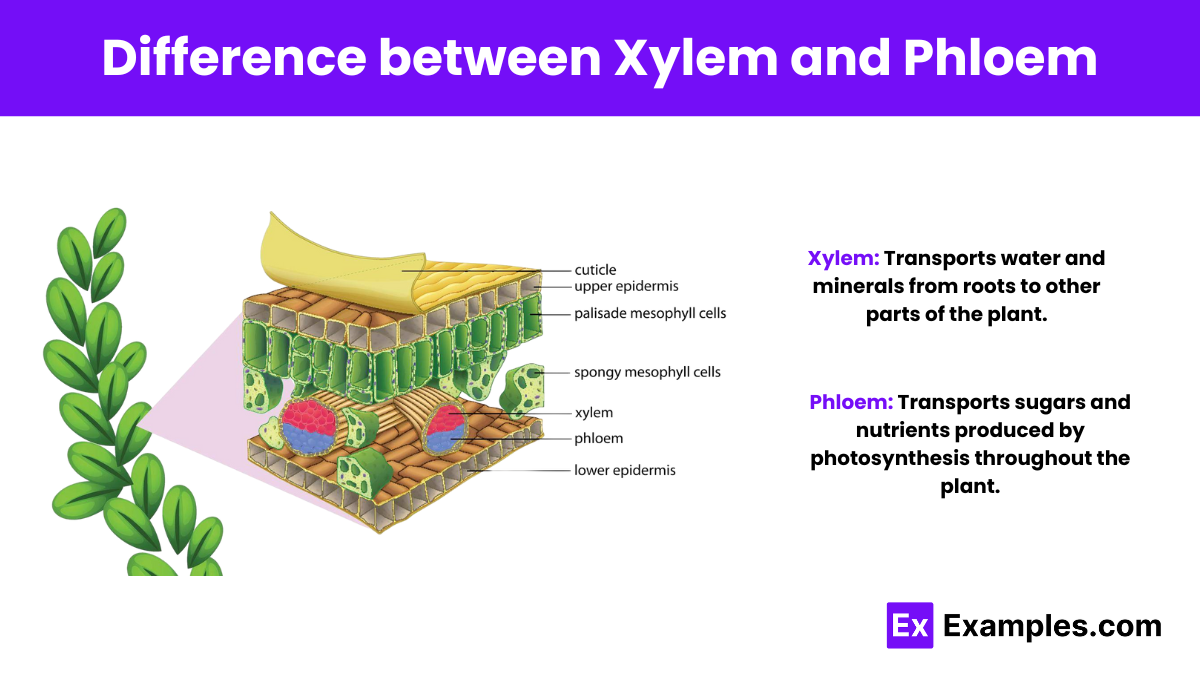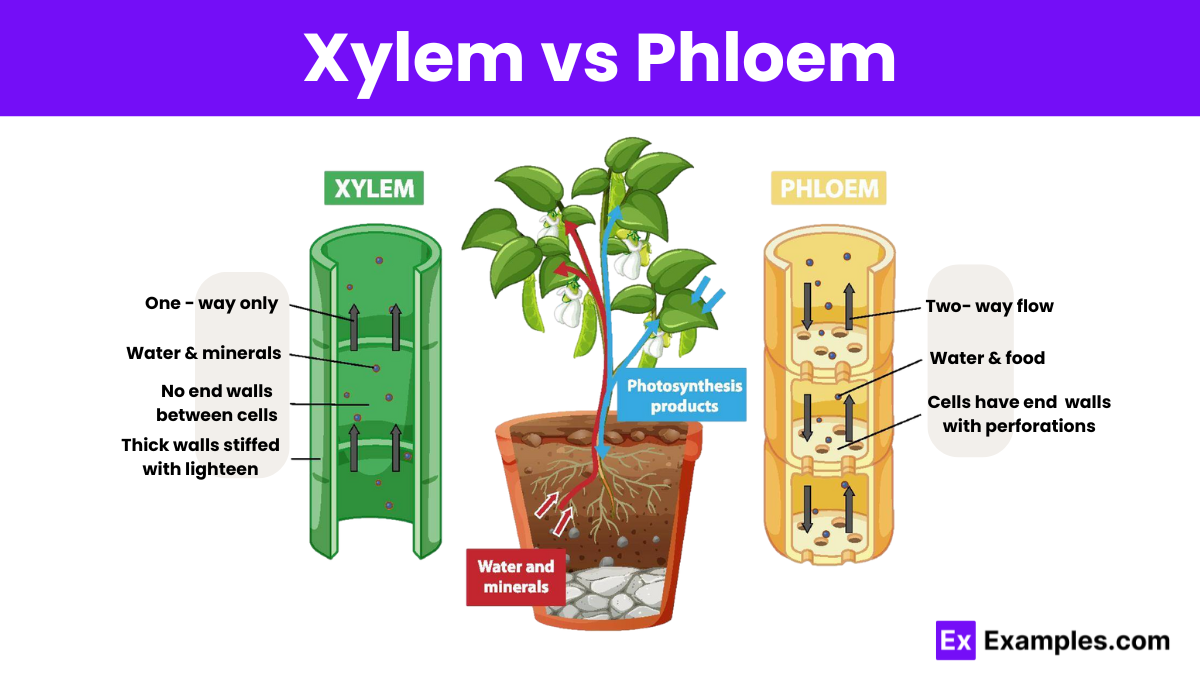Xylem vs Phloem
Plants are complex organisms that thrive through intricate systems, much like the circulatory system in animals. Two pivotal components of this botanical circulatory system are the xylem and phloem tissues, each playing a crucial role in sustaining plant life. These vascular tissues not only facilitate the movement of essential substances but also embody the remarkable adaptability and efficiency of plants. Let’s delve into the distinctive features and functions of xylem and phloem, shedding light on their critical roles in the plant kingdom.
What is the difference between xylem and phloem?
Xylem
Xylem serves as the plant’s hydration conduit, channeling water and dissolved minerals from the roots to various parts of the plant. Envision it as a series of interconnected pipes, each designed to conduct water efficiently upwards against gravity. Xylem’s structure is a testament to its function; composed of dead, hollow cells, it forms a rigid framework that supports the plant and facilitates water transport. This tissue is not just a passive channel but a dynamic system that adapts to the plant’s needs, ensuring that every leaf and stem receives the life-sustaining water it requires.
Key Characteristics of Xylem
- Structure: Tubular, with a star-shaped cross-section, devoid of cross walls, creating an uninterrupted channel for water flow.
- Location: Central in the vascular bundle, extending through roots, stems, and leaves.
- Composition: Consists of tracheids, vessel elements, and xylem fibers, each contributing to the tissue’s strength and transport capabilities.
- Functionality: Primarily transports water and minerals; provides structural support.
Phloem
Contrasting yet complementing the xylem is the phloem, the nutrient superhighway of the plant. Phloem distributes the sugars produced during photosynthesis from the leaves, where they’re generated, to parts of the plant where they’re needed or stored. This includes growing regions like buds and roots, as well as storage structures like fruits and tubers. The phloem’s bidirectional flow allows it not only to distribute nutrients but also to send chemical signals throughout the plant, coordinating growth and response to environmental changes.
Key Characteristics of Phloem
- Structure: Composed of sieve-tube elements and companion cells, phloem is tubular with thin sieve-like walls, allowing for the translocation of nutrients.
- Location: Situated peripherally in the vascular bundle, mainly within stems and leaves, extending to all growing and storage tissues.
- Composition: Features a variety of cells, including sieve tubes, companion cells, and phloem fibers, facilitating nutrient transport and providing structural support.
- Functionality: Transports sugars, amino acids, and other organic nutrients; plays a role in signaling and defensive mechanisms.
Differences Between Xylem and Phloem

| Feature | Xylem | Phloem |
|---|---|---|
| Primary Function | Transports water and dissolved minerals from roots to other plant parts. | Transports sugars and other nutrients from photosynthetic parts to the rest of the plant. |
| Direction of Transport | Primarily upwards, from roots to leaves. | Bidirectional, can move substances up and down the plant. |
| Components | Composed of vessels, tracheids, xylem parenchyma, and xylem fibres. | Consists of sieve tube elements, companion cells, phloem fibres, and phloem parenchyma. |
| Cell Type | Mostly composed of dead cells, except for xylem parenchyma. | Composed of living cells, except for phloem fibres. |
| Cell Wall | Thick walls, often lignified, providing structural support to the plant. | Thinner walls compared to xylem, not lignified. |
| Contribution to Plant Structure | Provides mechanical support and rigidity, contributing to the plant’s structural integrity. | Primarily involved in nutrient distribution, with lesser role in support. |
| Substances Transported | Water, mineral nutrients. | Organic nutrients (primarily sucrose), hormones, and some mineral ions. |
| Growth | Associated with primary and secondary growth, contributes to the thickening of plant structures. | Mainly associated with primary growth, with limited contribution to secondary growth. |
| Visibility | Often visible in the form of wood and tree rings in woody plants. | Less visibly distinct, often embedded within the plant tissue. |
Key Differences Between Xylem and Phloem
- Function:
- Xylem: Primarily responsible for the transport of water and dissolved minerals from the roots to various parts of the plant.
- Phloem: Conducts sugars and other metabolic products downwards from the leaves to other parts of the plant.
- Direction of Transport:
- Xylem: Transports substances in one direction, from the roots upwards to the stems and leaves.
- Phloem: Facilitates bidirectional movement, allowing nutrients to travel to growth sites and storage sites within the plant.
- Constituent Elements:
- Xylem: Composed of vessels, tracheids, xylem parenchyma, and xylem fibers.
- Phloem: Made up of sieve elements, companion cells, phloem parenchyma, and phloem fibers.
- Structural Composition:
- Xylem: The cells are typically dead and hollow, with thick walls that provide structural support to the plant.
- Phloem: Comprises living cells (except for the phloem fibers) with thin walls that facilitate the transport of organic nutrients.
- Type of Transported Substances:
- Xylem: Carries water and inorganic ions, predominantly.
- Phloem: Transports organic compounds, particularly sugars like sucrose, along with amino acids and other nutrients.
- Development:
- Xylem: Develops from the procambium and cambium, becoming functional after the cells are no longer alive.
- Phloem: Also originates from the procambium and cambium but remains alive at maturity to perform its functions.
- Presence in Plants:
- Xylem: Found throughout the plant, including in the roots, stems, and leaves.
- Phloem: Also present throughout the plant but is more concentrated in the areas where nutrients are synthesized or stored.
FAQ’S
What Does the Phloem Do?
Phloem transports sugars and nutrients from leaves to growth and storage areas in plants, facilitating essential metabolic functions.
What is the Main Difference Between the Direction of Flow in Xylem and Phloem?
Xylem flows only upwards from roots to leaves, while phloem’s flow is bidirectional, supporting various plant needs.
Is Xylem or Phloem for Water?
Xylem is specialized for water transport, moving water and minerals from roots to the rest of the plant.
What is the Function of the Xylem?
Xylem’s primary role is to conduct water and dissolved minerals from roots to stems and leaves, supporting plant hydration.


